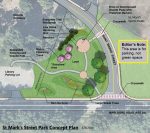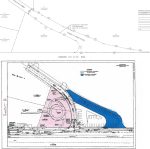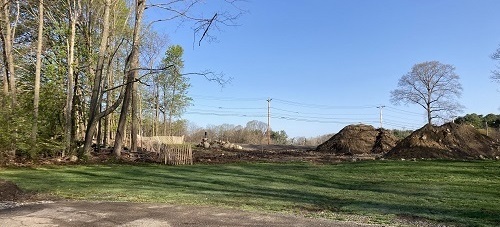Above: Voters will be asked to make a decision about the incomplete construction project on private and public land this weekend. (photo by Beth Melo)
Tomorrow, the Select Board will bring the controversial St. Mark’s Street relocation and park project back to Annual Town Meeting voters. The board’s handling of the project since rebuked by voters last spring has turned around some naysayers. But with a ⅔ approval from voters needed for Article 12, and some vocal opponents still raising questions, the board was already facing a tough sell.
That just got tougher with the release of the Planning Board’s report to the Select Board as a Town Meeting handout. In it, Planning highlights why it can’t support the street discontinuance included in the Article.
Planning’s letters highlight issues related to “ever changing” plan layouts that don’t conform with language in the Town’s legal agreement with St. Mark’s School for a land swap. The board lays out the technical and legal issues members believe need to be resolved before the current roadway can be discontinued and land swap approved. But, given the wording of the Memorandum of Understanding (MOU), the Town may not be able to continue pursuing the project if the Article is voted down on Saturday.
There have been a lot of publicly raised questions about the project including the history of the application for a shared street grant from MassDOT (Dept. of Transportation), how the funds were spent, and what the state was told. Although the Select Board has defended officials’ actions, under Chair, Kathy Cook (elected after last spring’s meeting), they have also acknowledged to critics that the project should have been handled better.
Since the May 2022 meeting, the board has pushed project critics to focus on, how do we best proceed from here? A major part of their pitch for Article 12 is to avoid spending more to get less. Not finishing the project requires repaying the $290K grant. And since the area was dug up as part of the project and some road work begun, the Town would have to also spend some funds to “clean up” the parcels.
 To promote what the Town could do if voters approve, the board pushed the St. Mark’s Street Park Working Group it created (and revamped), to solicit public feedback and develop a “consensus” concept plan for a park next to the Southborough Library. Their final concept was approved on March 6th. The board discussed the need for the draft image (right) to be corrected so that St. Mark’s School’s parking lot doesn’t look like green space. That image isn’t yet posted but will be shared in the Select Board’s presentation.
To promote what the Town could do if voters approve, the board pushed the St. Mark’s Street Park Working Group it created (and revamped), to solicit public feedback and develop a “consensus” concept plan for a park next to the Southborough Library. Their final concept was approved on March 6th. The board discussed the need for the draft image (right) to be corrected so that St. Mark’s School’s parking lot doesn’t look like green space. That image isn’t yet posted but will be shared in the Select Board’s presentation.
Thanks to archeologists hired by St. Mark’s, the Town also (hopefully) laid to rest concerns that the park might be on top of an indigenous burial ground. (You can read the findings here.)
That still left other major objections from voters last year to be resolved — using a license agreement to bypass Town Meeting authority over Town land rights and spending Town money on land owned by the private school for public use and public land for use by the private school. The board’s hope is to resolve those through a swap of land ownership, approved by Town Meeting voters. To ensure that voters didn’t question what that agreement might look like, the board decided to execute an MOU with the school in advance. The agreement was to layout all of the terms, to answer voter questions. It includes specification that if the project is approved, the Town won’t spend money on the area that would become St. Mark’s parking lot.
During discussions of the MOU, the board debated residents’ concerns that they would again be entering an agreement before getting voter approval. To assuage those concerns, they had clauses created to nullify the agreement if Town Meeting votes the land deal down. And to avoid claims that the board would proceed with a project even without voter approval, the MOU makes clear that if the vote fails, the only actions the Town can take on the parcels is cleanup.
In trying to work through the logistics, the board realized it would also need Town Meeting to approve discontinuing a section of the roadway. And here is where the Planning Board’s role officially enters.
Since last year, the Planning Board had been questioning the Select Board and DPW’s bypassing of Planning Board authority over the road relocation. Town Counsel informed Planning last spring that they didn’t need to oversee the physical relocation of the road until the Town sought to change the legal “right of way”, which could be pursued after the road project was completed. But the Town presumably can’t grant the school ownership of a legal right of way. So this winter, the Select Board recognized that the discontinuance of the section of road would need to be included in the Warrant Article.
Meanwhile, the Planning Board had been seeking the full size plans for the road. Those weren’t provided until January. At that time, the Town Planner determined that the engineers hadn’t included the drainage calculations the board needed for its review. In subsequent meetings, as more documents were submitted and others unearthed, more questions were raised. Board members expressed confusion and frustration when they discovered that although a prior section of the road had been discontinued by the DPW, it appeared the right of way had never legally been altered. They were unsure about how to legally proceed.
The board also expressed dismay in finding that plans they had been given didn’t match those on file as related to the land swap, and plan submissions kept changing. The project has never been surveyed, and they found serious questions about the boundaries for land St. Mark’s would be given ownership of and the width of the new road and right of way.
 In the board’s March 13th meeting, a new set of plans submitted hours before their meeting appeared to be a last straw for Chair Meme Luttrell. Calling the project a disaster, she followed:
In the board’s March 13th meeting, a new set of plans submitted hours before their meeting appeared to be a last straw for Chair Meme Luttrell. Calling the project a disaster, she followed:
I would love to be able to move forward in some kind of way that the town gets the greatest benefit of it. but it seems to me it’s not still not ready for prime time.
Luttrell noted that in past road discontinuances, “meets and bounds” were specified that are currently unclear. Member Andrew Mills said the board never would have given any other applicant the amount of time for reviewing the project as they had. They would have sent a developer away to come back when they had what was required to proceed. The positions of members Marnie Hoolahan and Debbie DeMuria were less of a surprise, since they had both been publicly questioning the project and process issues. But they and others ultimately pointed to their biggest concern, that they were too many unknowns about what they were being asked to vote on.
After agreeing (4-1**) on broad terms, the board designated Luttrell and Hoolahan to work together on the letters to be issued in the board’s name. The cover letter from Planning states:
the proposed conveyance and discontinuance. . . has significant deficiencies and many open, unanswered questions pertaining to the genesis of the portion of St. Mark’s Street slated to be discontinued, the ever-changing square footage of the discontinuance, MGL and zoning laws and regulations of the Town of Southborough. The plans provided to the Town for both components of the relocation project are incomplete and fail to meet the standards that the Planning Board requires from any submission it receives.
The Planning Board, in good faith, is unable to support Warrant Article #12. Based on our review of this project and its significant impact on public assets, including water and public safety infrastructure, we have concerns on moving the intersection and discontinuing the road. . . The ramifications of the project and all it’s moving parts, including disruption of land, deforestation, removal of historic stone walls, and potential addition of numerous impervious surfaces (parking lot, road, sidewalks, walkways, and pocket park) on the existing flooding conditions need to be clearly understood.
Ultimately, boards and committees should have had a role in the review and permitting process of this road project and encourage the Select Board to include the Planning Board for all future plans related to road relocations and development of parks. We proudly uphold our charter to serve the Town and protect the interests and safety of the public.
A backup letter highlights that the square footage described in the “proposed areas to be conveyed” in the MOU are not the same as identified on the Draft Discontinuance Plans.
The Planning Board’s handout posted to the Annual Town Meeting website is comprised of a cover letter with two backup letters detailing findings and recommendations (one focused on the intersection relocation and the second on the discontinuance of the old intersection). The original full version submitted to the Select Board includes an additional 27 pages of attachments referenced in the letters. (You can read that version here.)**
At Tuesday night’s Select Board meeting, the board didn’t mention the letter.
Certainly, Planning won’t be the only influencers making their opinions known at Town Meeting. The Advisory Committee has offered its support for Article 12 (and 13, which follows to provide the funding for the park). And, this morning I posted a support letter from Patricia Burns Fiore, who was one of the public opponents of the project last year. (Note: The park design recommended by the Working Group contains “simplified” elements co-proposed by Fiore.)
*The Town already spent the funds for drainage work and other construction related to the project, but not the construction of a publicly accessible park. MassDOT officials said that is fine as long as the park project gets completed in a reasonable timeframe. If it isn’t, the Town will need to reimburse the state for the grant.
**Worth noting, the letter refers to a 4-1 vote. The one (member Jesse Stein) wasn’t a clear vote to support the Article. Stein indicated he had many of the same concerns as fellow members, but wasn’t comfortable advocating that voters oppose the Article.


